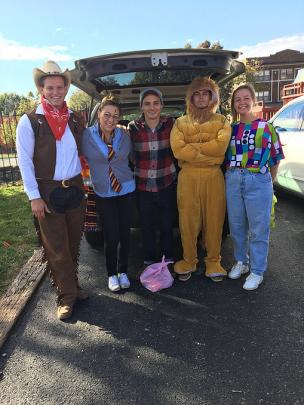Helzberg School of Management
In the Classroom: Learning by Doing in Organizational Behavior

When students filed in to Kelly Phipps’s Leadership and Organizational Behavior class at the beginning of the 2017 fall semester, the class felt regular and routine. However, once the syllabus was distributed and examined, students realized that the class would be far different than regular or routine.
The main project of the semester would be a group service project. Students were required to meet three different criteria for the project:
- Help someone in need
- Serve in solidarity with them
- Spend time planning their project
There were no additional requirements for the project besides these three. Students were given freedom to meet the requirements however they saw fit.
Yet, there was a catch. The teams students joined the first day of class would be their teams for the entire semester. Students would work with their teams for all class activities, exams, role playing activities and for their group service project.
The only restriction when choosing teams was that students could not initially be familiar with more than two people on their team, i.e. a group of five friends could not become a team.
Once teams were established, the course focused on the organizational behavior within each team and how to develop the teams toward producing the most successful group service project.
"I'm a firm believer that students learn best when they are doing, and that organizational behavior is a topic best learned in context. The service project allows the students to do something together that is a new context for them. It helps the students learn and apply the material to the environment," said Phipps.
One of the teams selected Amethyst Place, a non-profit recovery home located on Troost, for their service project. They worked hand-in-hand with Amethyst's volunteer coordinator, Lindsay Harmon, to put on a Trunk-or-Treat event for the mothers and children who live in the transition home. The Trunk or Treat served as an adaptation of the more traditional Trick-or-Treat, where, instead of going door to door throughout a neighborhood, families go “trunk to trunk” within a parking lot. Cars park with their trunks facing a central walkway, decorated and filled with sweet treats.
In addition to trunk-or-treating, the event featured face painting, games, activities, and a substantial amount of food thanks to sponsors like Cane’s, Insomnia Cookies, Donutology, and Waterway Carwash—all of which were secured through the group's outside organization contacts.
Such contacts, however, were not easily won.
"A challenge we faced throughout the project was the small timeframe we had to hear back from the companies we contacted. They wanted requests sent in early, but it couldn't be too early," said Natalie Wagner, Rockhurst junior.
Through transparent communication, persistence and collaborative work within their team, sponsors were secured, funds raised, and the event was successful and enjoyable.
These skills were all taught and discussed within the classroom, and applied to the context in which each group was working—exactly what Phipps seeks for his students to experience.
"I like the structure of Dr. Phipps's class...because he has us plan and execute a service project during the semester, we were able to put the things we learned into action," said Justine Howell, Rockhurst Sophomore.
The best part of the class, Phipps believes, is the outstanding work the students produce. "I'm consistently surprised by the high standards that students hold themselves to. Students tend to look for ways to go above and beyond," Phipps said. It is in this way that learning goes beyond the classroom and becomes tangible and practical for students. This is the experience students are after in higher education.
Brittany Meyer









